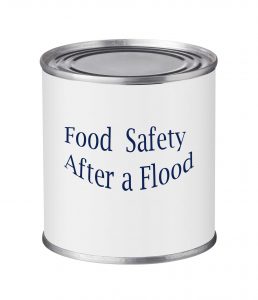The Flood’s Over – Now What?
When flooding has occurred, food safety begins. Never take a chance with food that may have been contaminated. Food-borne bacteria often cannot be detected by taste, smell or appearance. If in doubt – throw it out!
Flood water often contains sewage from municipal systems, septic tanks, lagoons and pastures. It may not be easy to determine if the water in your home is tainted. Therefore, it is best to assume that the water contains sewage and take the proper precautions.
Refrigerators and Freezers
Without power, with the appliance door closed tightly, a fully packed freezer can only keep food properly cooled for two days, and a half-full freezer for one day.
Discard all foods that may have been contaminated by flood waters or by raw meat juices.
Foods kept over two hours at temperatures above 40 degrees Fahrenheit, should be discarded, these include:
- Raw or cooked meat, poultry and seafood
- Milk and dairy products
- Cooked pasta and pasta salads
- Eggs
Items to keep
In emergency conditions, the following foods should keep at room temperatures for a few days. However, if in doubt-throw it out!
- Butter and margarine (If it’s warm, this stuff is going to be all mushy and melty at room temperature.)
- Dried fruits
- Opened jars of salad dressing, peanut butter, jelly, relish, taco sauce, barbecue sauce, mustard, ketchup and olives.
- Hard and processed cheese
- Bread, rolls, cakes and muffins
When power has been restored, check the freezer for uncontaminated food which still contain ice crystals. The crystals indicate that the foods are still partially frozen. These foods can be refrozen.
Vegetable gardens
Any fresh foods that might have come in contact with flood waters should be discarded, no mater how delicious they appear.
All fresh garden produce and items still growing in your garden should be discarded. Harmful bacteria from sewage often cannot be washed off and can even be taken into the plant through the vegetable skin.
Packaged Foods
The following items should always be discarded:
- Containers of nuts, spices, seasonings and flavorings
- Canisters or bags of grains, sugars, salt, coffee and tea
- Foods, packaged in paper, plastic, cloth, fiber or cardboard boxes
- Plastic bags of food (even if boxes and containers inside the bags seem dry).
- Bags/boxes of pasta, cereals, rice, dried milk, crackers, cookies or mixes.
- Bottled food in screw-topped or crimp-topped jars that have been touched by flood water, even when the jars have not been opened.
- Unopened jars with waxed cardboard seals, such a mayonnaise and salad dressing.
- Home-canned foods in glass jars, including jams, jellies, honey, molasses, syrups, fruits, pickles. There is no lid in use on glass food containers that will keep water out if the container is immersed.
Metal Canned Foods
Discard any canned items that are dented or rusted. Any remaining food cans need to be treated in the following manner:
- Write the food name on the container tip with a permanent marker.
- Remove the paper label.
- Wash the cans in a strong detergent solution with a scrub brush, removing all silt.
- Completely immerse scrubbed containers in a lukewarm solution of water and chlorine laundry bleach for one minute. Check your bleach bottle instructions for mixing solutions for disinfectant use or see instructions under Disinfecting below.
- Remove containers from the chlorine sanitizing solution. Place cans on a disinfected surface and air-dry before opening.
- Re-label with permanent marker, if necessary. Use as soon as possible, because container may rust. If rusted, discard.
Dishes and Utensils
Discard:
- Wood spoons
- Plastic utensils
- Plastic baby bottles, nipples and pacifiers
With proper washing and disinfection, you can save:
- Glass, ceramic dishes, china dishes, metal cookware, glass cookware, glass baby bottles and empty canning jars.
- Thoroughly wash the item in a strong detergent solution (DEFINE?)
- Disinfect china and glass dishes in a chlorine disinfectant solution
- Disinfect metal pots, pans and utensils by boiling in clean water for 10 minutes. Let items air dry, do not use dish towels.
- Do not wash dishes in dishwasher unless the water is safe to drink and the sewer line works.
Disinfecting
Household bleaches contain from two to six percent chlorine. The amount of bleach to mix with water depends on the percent of chlorine the bleach contains. Adding more chlorine than specified will not improve its sanitizing effectiveness. Check the bottle label and follow these guidelines:
| Percentage | Amount per quart | Amount per gallon |
|---|---|---|
| 2 Percent | 2 teaspoons | 2 tablespoons |
| 4 Percent | 1 teaspoon | 1 tablespoon |
| 6 Percent | 1/2 teaspoon | 2 teaspoons |
Source: https://datcp.wi.gov/Pages/FoodSafetyFloods.aspx




